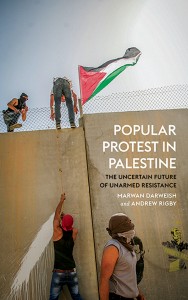By: Marwan Darweish and Andrew Rigby
University of Chicago Press, 2015, 224 pages, US$ 28.00
Reviewed by: Thimna Bunte
…………………………………………….
In the most insightful, comprehensive, and sensitive study of today’s Palestinian popular resistance, Marwan Darweish and Andrew Rigby provide an excellent analysis of Palestinian unarmed resistance to the Israeli occupation and the reasons why it has not developed into a popular-based mass movement. Woven into their analysis is an understanding of Palestinian unarmed resistance in a different role – one that opens up the potential for hope.
 The decline of Palestinian unarmed resistance
The decline of Palestinian unarmed resistance
“We came alive in the first Intifada. Then we died in the second. Maybe now we are being reborn.” Such was the spirit of hope among large segments of the Palestinian population in the wake of popular unarmed resistance after the second Intifada. Examining this movement in the decade before 2014, Darweish and Rigby reveal the obvious: Despite some success stories, unarmed resistance by Palestinians to the Israeli military occupation failed to develop into a popular mass movement; rather it consists of “localized pockets.”
The authors’ interviews with more than 100 Palestinian and Israeli activists and politicians reveal that Palestinian activists are fully aware of the fundamental weaknesses of the civil resistance movement. In order to understand why these weaknesses exist, the authors analyze different phases of Palestinian unarmed resistance since the late nineteenth century.
Darweish and Rigby identify three major challenges for Palestinian unarmed resistance today. First, any significant sense of solidarity among Palestinians has been eroded by geographical fractures introduced by the Oslo Process, economic impoverishment, the NGO isolation of community-based organizations, and the public’s disillusionment with the Palestinian Authority and divided political leadership. Second, rather than having a unified body that leads the struggle, as during the first Intifada, there are various coordination bodies that display organizational rivalry and compete over actions, media presence, and funding. Third, there is no effective popular resistance strategy shared by the movement. The once-important strategic goal of exerting direct leverage over the Israeli population is scarcely possible anymore.
Whilst their convincing analysis gives a pessimistic outlook, Darweish and Rigby see ground for hope in increasing third-party solidarity. Thus, they suggest an understanding of Palestinian unarmed resistance as part of a chain of influence, in which third parties exercise leverage over the Israeli public and decision-makers.
The boomerang pattern
The idea is simple: currently Palestinian unarmed resistance cannot effectively reach Israeli society or decision-makers who could end the occupation. It can, however, influence external solidarity actors who then reach out to their own societies, governments, NGOs, and the international community. Those, in turn, have the power to influence the Israeli public and decision-makers.
Ideally, this would unleash what Darweish and Rigby call a “boomerang pattern.” Because neither the Israel government nor society is responsive to Palestinian unarmed resistance, the activists “throw a boomerang” out to external actors and networks, naming and shaming their oppressors, in the hope that the boomerang would return and hit the target with international pressure, particularly from international allies of the targeted regime. The authors correctly state that such chains of influence already exist, most significantly with the boycott, divestment, and sanctions movement (BDS), which was established in 2005. However, in order for the boomerang effect to work successfully, hopes should not be put only on outside actors. Palestinian unarmed resistance, international solidarity, financial institutions, and governments all need to do their part to make the occupation too costly for Israel. Interestingly, in their conclusion, the authors only give recommendations for the Palestinian part of the chain.
Darweish and Rigby hesitate to assert that a boomerang pattern is likely to succeed. Nevertheless, with this understanding they offer something beyond a convincing strategic outlook – they offer a valuable contribution in countering the frustration within popular resistance. The significance of suggesting the understanding of Palestinian unarmed resistance as one part of a chain of influence is that it moves away from the perception of failure to end the occupation towards an understanding of popular resistance in the role of an already emerging boomerang thrower. If Palestinian unarmed resistance decided to understand itself more in this role, it could build more effectively on its already existing expertise as activists and advocates. This can be a valuable impulse for Palestinian activists in their own strategizing process and role definition – and it can be grounds for hope.
In a book that focuses on the popular struggle in Palestine, it is understandable that Darweish and Rigby center their analysis on Palestinian resistance. Unfortunately, they do not use the valuable information they gathered on Israeli activism, international humanitarian aid agencies, and international solidarity in the same fruitful and inspiring way.
Still, Darweish and Rigby have succeeded in publishing the best available analysis of today’s Palestinian popular resistance movement against the wall and the settlements. They offer meaningful impulses for discussion for the Palestinian movement and their strategizing processes as well as potential for hope. In all, Popular Protest in Palestine is a highly recommended read for Palestinian, Israeli, and international solidarity activists. It now remains to be seen if and how they pick up on these insights and use them to move from a perception of failure toward a different strategic understanding of their role in ending the Israeli occupation – toward hope for change.

